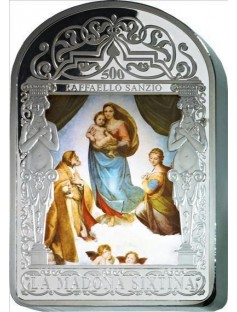Andorra 2012 100 Dinars Madonna Sistine Raphael 1kg Proof Silver Coin Kilo Set
- Mintage Limit - 500
- Madonna Sistine Madonna Raphael 1kg Proof Silver Coin
- This amazing set contain 1KG pure silver coin
- Coin in capsule+with Certificate of Authenticity + BOX
Coin with incomparable beauty and value makes a perfect memento to one of the most representative masterpiece of Italian Renaissance, "The Sistine Madonna", painted by Raphael. To mark the 500th birthday of this masterpiece, Andorra will issue its very first commemorative kilo coin ever!
Coin with a particular rectangular shape and a top part as convex ellipse arch depics the opera "Sistine Madonna" also called La Madonna di San Sisto, an oil painting by the Italian artist Raphael. For many people it remains the supreme example of western painting, and its popularity is virtually as great as that of the Mona Lisa. The coin’s obverse depicts the Principat d'Andorra emblem.
HISTORY
The Sistine Madonna is a painting by the Italian High Renaissance artist Raphael, circa 1512–1514. It is housed in the Gemäldegalerie Alte Meister (old masters) of Dresden, Germany.
The canvas with the Virgin, Child and Saints Sixtus and Barbara, usually called the Sistine Madonna, is characterized by an imaginary space created by the figures themselves. The figures stand on a bed of clouds, framed by heavy curtains which open to either side. The Virgin actually appears to descend from a heavenly space, through the picture plane, out into the real space in which the painting is hung. This is seen by the active focal point in Madonna's knee. The gesture of St. Sixtus and the glance of St. Barbara seem to be directed toward the faithful, whom we imagine beyond the balustrade at the bottom of the painting. The Papal tiara, which rests on top of this balustrade, act as a bridge between the real and pictorial space.
The painting was probably intended to decorate the tomb of Pope Julius II. It was for some time located in the convent of St Sixtus in Piacenza and was later donated by the monks to Augustus III of Saxony.
The two putti at the foot of the painting and the figure of St. Barbara have often been reproduced in popular culture, such as Christmas cards.



